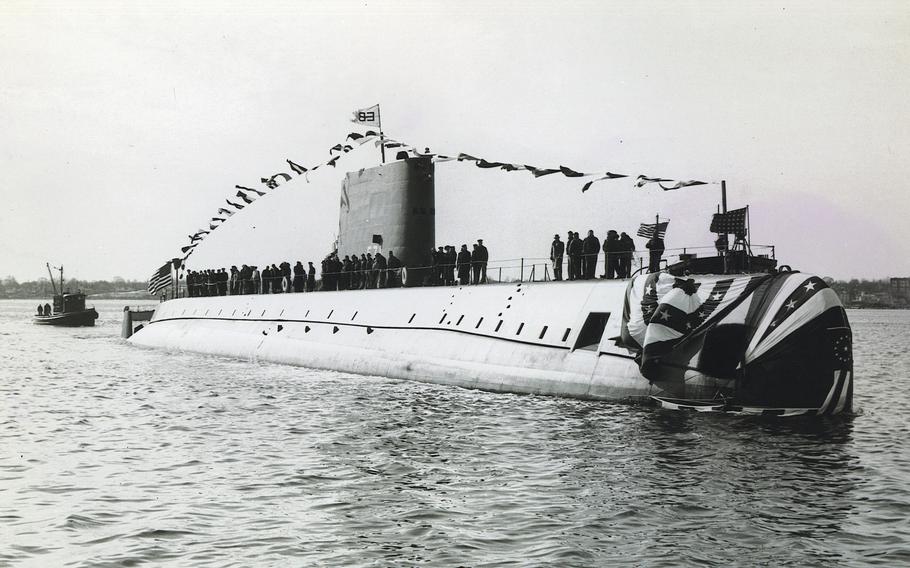
In this file photo taken Jan. 21, 1954, the nuclear-powered submarine USS Nautilus (SSN 571) is in the Thames River shortly after a christening ceremony. (U.S. Navy)
For generations, the concept of nuclear power as a sustainable energy source has been unreasonably scrutinized and critiqued. Even though most scientists and experts have proven its sustainability and safety, groundless fear and governmental hesitance still envelop the nuclear power debate. With hefty climate goals put forth by the current administration, there remains no definitive route to achieve them, making it clear that the United States needs to improve climate infrastructure, including nuclear technology. The hypocritical notion that reactor plants should close not only inhibits that improvement but directly imposes upon American defense.
While many think of reactor technology as a recent invention, the United States Navy begs to differ. With the concept of a marine vessel that would not have to make routine fuel stops, naval research on nuclear fission began in the early 1940s and propelled itself into service in 1955 with the commissioning of the USS Nautilus. As the first nuclear-powered underwater vessel, submarines were transformed from diesel-powered tubes with brief underwater stints to submersible warships capable of traveling for months on end, giving way to an endless array of possibilities for the Navy.
With 26 nuclear-powered submarines operating in 1962, and 30 more under construction at the time, the U.S. led the way in the nuclear sector. Nuclear surface vessels began to arise around the same time. The USS Enterprise was constructed in 1960 as the first nuclear aircraft carrier, and the USS Long Beach was completed in 1961 as the first vessel with two reactors aboard. Consequently, maritime reactor technology became worldly profound to the point where it was being shared with Great Britain. While other countries such as China and Russia attempted to develop their own reactors upon naval vessels, the United States is the only nation to have had no issues in development and follow-through.
To date, the U.S. Navy has had a flawless record of operation. Touted by the likes of late Sen. John McCain, nuclear power has demonstrated its worth through 134 million cumulative miles traveled and over 5,700 reactor-years of operation amassed. Meant to withstand the most capable attacks during wartime, these pressurized water reactors are built with the safety of the crew and all inhabitants of maritime vessels in mind. Safeguarded by damage control capabilities, crewmembers can live within close proximity to these power sources and maintain normal health with minimal risk. So why hasn’t the civilian sector followed suit?
When taking a deeper look into the nuclear Navy, its policies are held to a stringent military standard alongside a training program that cultivates the country’s next generation of nuclear operators. Built upon the principles of technical leadership, integrity and excellence, enlisted sailors acquire the knowledge to operate on nuclear reactors through a multi-tiered training pipeline where they must consistently demonstrate not just what to do in any given scenario, but an understanding of why elements within a reactor work the way they do. Coupled with a reactor structure fortified by welded protection, naval procedures allow for practically no radiation to be released, making nuclear power the most sustainable fuel source in comparison to alternatives.
While nuclear power distinctly provides a demonstrated and effective means of energy that transcends all others, the threat of plant retirement remains imminent, seen most notably in Illinois and New York. With half of the remaining nuclear reactor plants scheduled to retire by 2030, there has been no policy intervention, jeopardizing the emissions goals that the country has put forth. In combating that narrative, the facts do not lie — nuclear power provides 52% of the United States’ clean energy, it is safe to the highest degree, and outdated nuances such as nuclear waste disposal are no longer cause for concern. Coupled with the fact that nuclear plants provide jobs to thousands of Americans per year, closing all of these plants would be devastating to the economy.
In order to keep nuclear power economically feasible in America, the long-winded regulation needs to be trimmed down. Studies show that regulations introduced in the 1970s caused construction costs of nuclear plants to skyrocket by 200%. Additionally, the permitting process for a nuclear power plant takes approximately 80 months, with $60 million in permitting costs on average per the Nuclear Regulatory Commission. With a process as extensive as this, the ability of a nuclear power plant to get off the ground remains increasingly difficult, which is unfair given the clearly articulated benefits of nuclear power.
In a political climate inundated with energy uncertainty, the U.S. Navy provides the country with a glimpse of the fullest capabilities of clean energy. Traversing the globe, visiting foreign ports, and providing humanitarian relief, the Navy does some of the most influential work in the world — and it is fueled by nuclear power. If our government can ease some of the destructive barriers it has put up for commercial nuclear power, and allow the industry to operate like the Navy’s nuclear program, the result would be job creation, a decrease in greenhouse gases, and more clean energy. It is pertinent for the safety of this country and the stability of the world that the rest of the U.S. set sail alongside the Navy and adopt nuclear power as a streamlined energy source.
Randy Breigle is an enlisted member of the United States Navy and a member of the American Conservation Coalition.